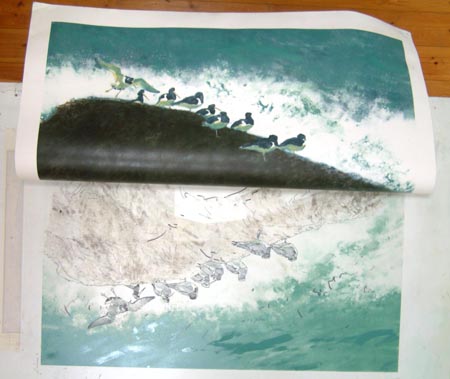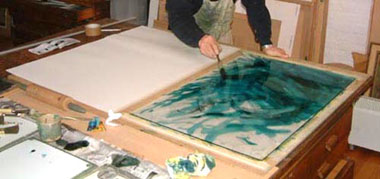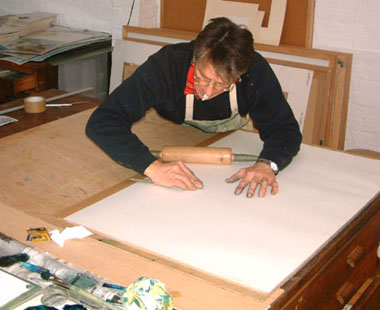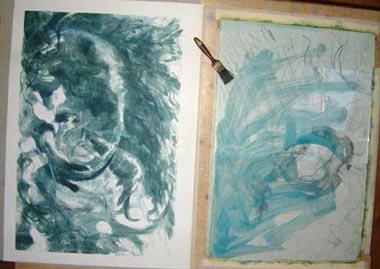Monotype is a print made from a wet painting on a non-absorbent surfaces such as glass, Plexiglas, or metal that is transferred to paper either by the pressure of the hand or an etching or lithographic press. It is sometimes possible to pull a second or "ghost" impression from a monotype plate, especially if a press is being used. Often the artist will rework areas of the plate between the first and second printings or use more than on plate, but the second impression never exactly the same as the first. Many types of pigment can be used, including oil paints, acrylics, printer's ink, enamels, watercolors, and gouache, depending on the desired effect. Whatever the pigment, the transfer process entails a metamorphosis between the image as drawn or painted on the plate and the image as it ultimately appears on the paper.
The monotype/monoprint method excludes one of the main purposes of printmaking, which is to obtain multiple impressions of a single image. Instead, this versatile printmaking process ends with a single image of painterly textures and surface effects you can't get any other way.
High tide, low light
Monotype ( 36ins x 24ins)
This image was created by a slightly different monoprinting method. The surface I worked on was True-grain, a high quality textured polyester drawing film for artists and printmakers, (see John Purcell Paper). With soft black watercolour pencil and water soluble sticks I drew out my idea using line and larger areas of tone. On a fairly damp sheet of Heritage paper I pressed the image - the water in the paper lifting off very exciting lithographic-like marks.
I then worked the image two or three times again using different colours which combined to build an image with a rich and wide tonal range.

Creating a monoprint image

Using printing inks or oil paints, (or sometimes both)
different layers and textures of colour are laid on the
glass plate with rollers, brushes, strips of card, or any
inventive combination of methods. (A guide drawing can be placed under the glass). The inked surface can then
be manipulated in a huge variety of ways - by wiping
and smearing, the ink can be partly lifted with soft tissue,
scratched with a wooden spatula or drawn into with a sharp stick - any
method which reflects the character of the creative idea one is trying
to express.

A
sheet of dampened
paper is then laid on the plate and carefully pressed into the ink
using a large wooden roller, a smaller softer rubber roller, a
burin, or even the smooth back of a wooden spoon to lift off small
areas of ink. At various stages a corner of the paper can be
lifted to asess where a little extra pressure should
fall so more ink is drawn onto the paper.


Once folded back the image can be assessed and decisions made about a second colour.